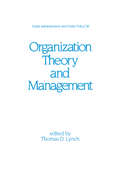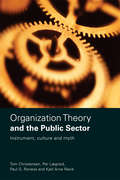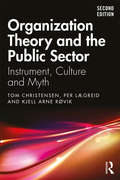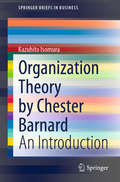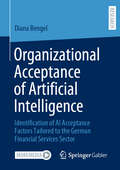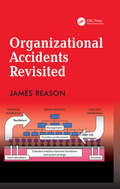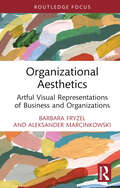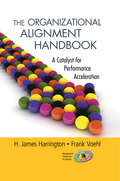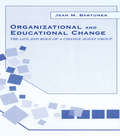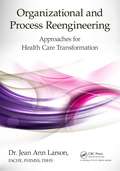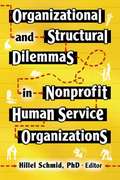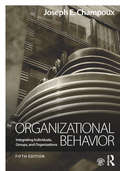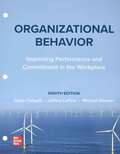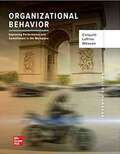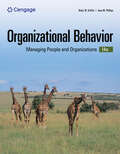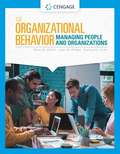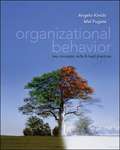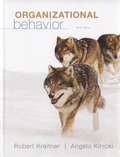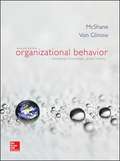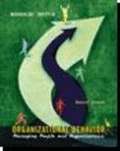- Table View
- List View
Organization Theory and Management: The Philosophical Approach, Second Edition (Public Administration And Public Policy Ser. #116)
by Thomas D. LynchThis book reviews the evolution of organization theory literature and explains other theories of organization and the implicit wisdom of the instructor's favorite theory. It helps the reader to understand the relevance of organization theory to the problems of administering public organizations.
Organization Theory and the Public Sector: Instrument, Culture and Myth
by Tom Christensen Per Lægreid Paul G. Roness Kjell Arne RøvikPublic sector organizations are fundamentally different to their private sector counterparts. They are multi-functional, follow a political leadership, and the majority do not operate in an external market. In an era of rapid reform, reorganization and modernization of the public sector, this book offers a timely and illuminating introduction to the public sector organization that recognizes its unique values, interests, knowledge and power-base. Drawing on both instrumental and institutional perspectives within organization theory, as well as democratic theory and empirical studies of decision-making, this text addresses five central aspects of the public sector organization: goals and values leadership and steering reform and change effects and implications understanding and design. This volume challenges conventional economic analysis of the public sector, arguing instead for a democratic-political approach and a new, prescriptive organization theory. A rich resource of both theory and practice, Organization Theory for the Public Sector: Instrument, Culture and Myth is essential reading for anybody studying the public sector.
Organization Theory and the Public Sector: Instrument, Culture and Myth
by Tom Christensen Per Lægreid Kjell Arne RovikPublic-sector organizations are fundamentally different from their private-sector counterparts. They are part of the society’s political organizations and are major political actors. They are multifunctional, follow a political leadership, and the majority do not operate in an external market. In an era of rapid reform, reorganization and modernization of the public sector, this book offers a timely and illuminating introduction to the public-sector organization that recognizes its unique values, interests, knowledge and power base. Drawing on both instrumental and institutional perspectives within organization theory, as well as democratic theory and empirical studies of decision-making, the book addresses five central aspects of the public-sector organization: ■ goals, values and motivation ■ leadership and steering ■ reform and change ■ effects. learning and implications ■ understanding and design The book challenges conventional economic analysis of the public sector, arguing instead for a political-democratic approach and a new prescriptive organization theory. A rich resource of both theory and practice, Organization Theory and the Public Sector: Instrument, culture and myth is essential reading for anybody studying the public sector. This second edition of the book contains a range of new and updated themes, examples and references.
Organization Theory by Chester Barnard: An Introduction (SpringerBriefs in Business)
by Kazuhito IsomuraThis book helps undergraduate and graduate students understand Chester Barnard’s organization theory. Barnard’s book The Functions of the Executive is a classic that, along with Herbert Simon’s Administrative Behavior, is often considered to be essential reading for management students. However, it is well known to be difficult and abstract. Offering a systematic overview, this book provides an excellent introduction to Barnard’s organization theory.Chester Barnard’s concept of formal organization is often cited as a definitive opus on the subject of organization. However, he provided other concepts of organization, such as cooperative systems, complex formal organizations, and informal organizations. In his second book, Organization and Management, he added two more concepts, lateral organizations and status systems, allowing researchers to gain a better understanding of how Barnard developed his organization theory after his first publication.Barnard was a successful practitioner as well as a theorist, and his organization theory is full of practical insights gained from managing various types of organizations, including NGOs and NPOs. This book discusses how Barnard’s organization theory can be applied to business practices in the context of exploring a new style of management, and provides suggestions for business people seeking innovations for their own organizations.
Organizational Acceptance of Artificial Intelligence: Identification of AI Acceptance Factors Tailored to the German Financial Services Sector
by Diana BengelThe book investigates the determinants which are influencing the acceptance of artificial intelligence (AI) in an organizational context, focusing on the German financial services industry. An AI-specific acceptance model is being developed based on technology acceptance models as well as being enriched with practical insights from industry experts. Ultimately, the acceptance of artificial intelligence is influenced by multiple, interrelated variables, which can be classified into five major dimensions: organizational, individual, financial, technological and societal factors.
Organizational Accidents Revisited
by James ReasonManaging the Risks of Organizational Accidents introduced the notion of an ’organizational accident’. These are rare but often calamitous events that occur in complex technological systems operating in hazardous circumstances. They stand in sharp contrast to ’individual accidents’ whose damaging consequences are limited to relatively few people or assets. Although they share some common causal factors, they mostly have quite different causal pathways. The frequency of individual accidents - usually lost-time injuries - does not predict the likelihood of an organizational accident. The book also elaborated upon the widely-cited Swiss Cheese Model. Organizational Accidents Revisited extends and develops these ideas using a standardized causal analysis of some 10 organizational accidents that have occurred in a variety of domains in the nearly 20 years that have passed since the original was published. These analyses provide the ’raw data’ for the process of drilling down into the underlying causal pathways. Many contributing latent conditions recur in a variety of domains. A number of these - organizational issues, design, procedures and so on - are examined in close detail in order to identify likely problems before they combine to penetrate the defences-in-depth. Where the 1997 book focused largely upon the systemic factors underlying organizational accidents, this complementary follow-up goes beyond this to examine what can be done to improve the ’error wisdom’ and risk awareness of those on the spot; they are often the last line of defence and so have the power to halt the accident trajectory before it can cause damage. The book concludes by advocating that system safety should require the integration of systemic factors (collective mindfulness) with individual mental skills (personal mindfulness).
Organizational Aesthetics: Artful Visual Representations of Business and Organizations (ISSN)
by Barbara Fryzel Aleksander MarcinkowskiOrganizational Aesthetics attempts to reconstruct artful representations of the organizational world and businesspeople. It looks at organizations and management through the eyes of artists, painters, and photographers and decodes meanings contained in artistic messages, grasping the aesthetic perceptions of the world of management and organization. Paintings and photos are analysed using qualitative methods from the social sciences as well as from the art analysis tradition. The novelty of the presented approach rests in the original method of parallel dialogues, taking place both in the institutional sphere and between co-authors. The institutional aspect covers a practical, business perspective and extends the narrow framework of a single discipline. It complements academic rigour with elements of digression and free conversation, revealing a variety of nuances for which conventional research paradigms do not always allow. Readers will receive a proposal on how to integrate diff erent approaches to organizational analysis stemming from artistic, managerial, and academic experiences.
Organizational Alignment: The 7-S Model
by Jeffrey L. BradachPresents the 7-S framework. This framework offers managers a tool for diagnosing problems in their organizations and for proposing corrective courses of action. May be used with cases that deal with organizational alignment.
Organizational Alignment Exercise
by John J. Gabarro Michael BeerPresents an overview of a method for diagnosing and developing an organization's capability to achieve its goals and implement its strategy, with exercises for application. A rewritten version of an earlier exercise.
The Organizational Alignment Handbook: A Catalyst for Performance Acceleration (Management Handbooks For Results Ser.)
by H. James Harrington Frank VoehlIn the same way that a well-defined approach is needed to develop an effective strategic plan, an equally well-designed approach is needed to support the alignment of your organization's structure, management concepts, systems, processes, networks, knowledge nets, training, hiring, and reward systems. Examining top-down, bottom-up, and core plannin
Organizational Alignment, Performance, and Change in Professional Service Firms
by John J. GabarroThis note describes the relationship between organizational alignment and performance in professional service firms and how to use McKinsey 7S Alignment to diagnose a firm's or practice's alignment, identify misalignments and determine how to bring about the changes needed to re-align.
Organizational and Educational Change: The Life and Role of A Change Agent Group (Organization and Management Series)
by Jean M. BartunekJean M. Bartunek, the 2001-2002 President of the Academy of Management, has written an excellent scholarly book on organizational and educational change. Using a joint insider/outsider approach, this book tells the story of a change agent group--a group of teachers--that was creating change in its organization setting, a Network of Independent Schools. The group's focus was on empowerment and professional development for teachers in the Network. The book describes virtually everything that happened in the group over its first seven years and summarizes what happened during its final two years. It explores the identity, work, and evolution of change agent groups in organizations, with particular emphasis on teachers and educational change. Through the book's extensive quotations and narrative account, the reader is enabled to enter into the world of the teacher group studied over the course of its nine-year history. In addition, the book includes analysis of the underlying processes involved in the change, focusing on the change agent group's identity, its actions and relationships with stakeholders as they jointly evolved over time, and their impacts on the vitality of the change effort. It contributes a new understanding of fundamental processes involved in organizational change, especially when viewed from the perspective of change agents. In addition, the book provides practical implications for change agents, specifically change agents in schools. As such, this account will be useful for graduate students and researchers in organizational change, educational leadership, and professional development. It is a part of Lawrence Erlbaum Associates growing series in organization management.
Organizational and Process Reengineering: Approaches for Health Care Transformation
by Jean Ann Larson FACHE FHIMSS DSHSWinner of the Healthcare Information and Management Systems Society‘s (HIMSS) 2015 Book of the Year AwardGiven the on-going changes and challenges faced by today‘s health care organizations, Organizational and Process Reengineering Approaches for Health Care Transformation provides a practical, leader-led and team-based approach for reengineering o
Organizational and Structural Dilemmas in Nonprofit Human Service Organizations
by Hillel SchmidImprove your organization&’s performance for the well-being of your clients! Organizational and Structural Dilemmas in Nonprofit Human Service Organizations explores the common pitfalls that plague nonprofit human service organizations and cause them to fail in their missions. In this book, leading scholars analyze and evaluate the inherent difficulties that impede effectiveness in these organizations. With this wide-ranging body of knowledge, research findings, and information, you will be able to identify key areas in your organization that may become troublesome at a later date and prevent them from deteriorating. This valuable tool also includes advice and suggestions for repairing detrimental situations that have already occurred or are taking place. The book supplies solutions for repairing or preventing any permanent damage to your organization&’s structure, value, or reputation. Organizational and Structural Dilemmas in Nonprofit Human Service Organizations will help you set successful long-term strategies for your organization, despite changes in laws, programs, and public sentiment. With this book, you will learn more about: the changing identity of federated community service organizations the role of congregations as social service providers volunteer and paid staff relations the implications of welfare-to-work programs the cycles of public sentiment as expressed through the media the issue of nonprofit executive misbehavior the preferences of social work graduates for employment in various sectors of the welfare economy such as for-profit as opposed to nonprofit the differences between for-profit and nonprofit organizations
Organizational Behavior
by Talya BauerTwo leading researchers in Management, Talya Bauer and Berrin Erdogan, bring you a new Organizational Behavior textbook that bridges the gap between theory and practice with a distinct experiential approach. On average, a worker in the USA will change jobs 10 times in 20 years. In order to succeed in this type of career situation, individuals need to be armed with the tools necessary to be life-long learners. To that end, this book is not be about giving students all the answers to every situation they may encounter when they start their first job or as they continue up the career ladder. Instead, this book gives students the vocabulary, framework, and critical thinking skills necessary to diagnose situations, ask tough questions, evaluate the answers received, and to act in an effective and ethical manner regardless of situational characteristics. Often, students taking OB either do not understand how important knowledge of OB can be to their professional careers, or they DO understand and they want to put that knowledge into practice. Organizational Behavior by Bauer and Erdogan takes a more experiential angle to the material to meet both of those needs. The experiential approach can be incorporated in the classroom primarily through the OB Toolbox. This feature brings life to the concepts and allows students to not only see how the OB theories unfold, but to practice them, as well.
Organizational Behavior: Integrating Individuals, Groups, and Organizations
by Joseph E. ChampouxThe fourth edition of Organizational Behaviour: Integrating Individuals, Groups and Organizations is a well-organized introduction to the current field of organizational behavior with in-depth coverage of the most critical concepts. Its practical approach shows the power of organizational behavior theory for understanding one's behavior and the behavior of others in any organization. Although firmly grounded in behavioral science theory and research, the text is not a compendium of research findings. Champoux includes examples and builds frameworks that make the material clear and easy to understand. The concise format allows the text to be used as a primer or to be supplemented with additional cases, readings, or exercises. More interactive than in previous editions, this text provides students with several online features to reinforce their knowledge of chapter content with exercises, practice and other learning opportunities. An extraordinary supplementary package, all prepared by the author, is innovative and extensive in its content.
Organizational Behavior: Integrating Individuals, Groups, and Organizations
by Joseph E. ChampouxThe new edition of this essential resource in organizational behavior provides a balanced framework to understand the impact of increasing dynamism and complexity, the importance of collaboration, and the implications for organizational strategy. Covering both psychological and sociological perspectives on organizational behavior, this clearly written and presented textbook offers a comprehensive review of classic organizational behavior theories and approaches, illustrated with updated case studies. The sixth edition includes new material on ethical considerations; international contexts, with renewed attention to Africa and Asia; environmental pressures and responses; groups and intergroup processes; and the vital importance of building change readiness in any organization. Upper-level business and technology students, as well as professionals in executive education courses, will find the book a useful guide to all facets of organizational behavior. A companion website, featuring an instructor manual, test bank, and PowerPoint slides, provides additional support for students and instructors.
Organizational Behavior: Improving Performance and Commitment in the Workplace
by Jason A. Colquitt Jeffery A. LePine Michael J. WessonColquitt, LePine, and Wesson’s, Organizational Behavior 8th edition continues to offer a novel approach that uses an integrative model to illustrate how individual, team, leader, and organizational factors shape employee attitudes―and how those attitudes impact job performance and organizational commitment. This model reminds students where they are, where they've been, and where they're going while elevating two topics that receive less coverage in other books: job performance and organizational commitment. The text also continues to include features that encourage students to see OB concepts playing out all around them, such as OB on Screen, OB at the Bookstore, and OB Assessments.
Organizational Behavior: Improving Performance and Commitment in the Workplace
by Jason Colquitt Jeffery LePine Michael WessonColquitt, LePine, and Wesson’s, Organizational Behavior 7th edition continues to offer a novel approach using an integrative model and roadmap to illustrate how individual, team, leader, and organizational factors shape employee attitudes, and how those attitudes impact performance and commitment. <p><p>This model reminds students where they are, where they've been, and where they're going. They include two unique chapters on job performance and organizational commitment. Those topics are critical to managers and students alike, and represent critical outcomes in OB. Each successive chapter then links back to those outcomes, illustrating why OB matters in today's organizations.
Organizational Behavior: Managing People and Organizations
by Ricky W. Griffin Jean M. PhillipsBalance today's most recent organizational behavior developments and trends with proven classic management ideas when you use Griffin/Phillips' ORGANIZATIONAL BEHAVIOR: MANAGING PEOPLE AND ORGANIZATIONS,14E. This applied, student-oriented approach emphasizes how to think and act like a successful manager as students examine the fundamentals of employee behavior. Updated learning features and chapter-opening "Real-World Challenges," the latest research findings and revised content all reflect today's most recent changes in organizational behavior (OB). Current, applied examples from well-known organizations work with in-chapter cases, self-assessments, video cases and exercises to create a reader-friendly focus. Students examine OB's most pressing issues as they develop the skills, tools and resources to personally succeed and effectively lead others in the modern workplace. MindTap digital resources further reinforce critical OB concepts.
Organizational Behavior: Managing People And Organizations (Mindtap Course List)
by Ricky W. Griffin Jean M. Phillips Stanley M. GullyPrepare to think and act like a successful manager with the powerful insights, proven concepts and reader-friendly approach found in Griffin/Phillips/Gully's ORGANIZATIONAL BEHAVIOR: MANAGING PEOPLE AND ORGANIZATIONS, 13E. This edition equips you with the skills and practical understanding to meet modern management challenges. Examine the fundamentals of employee behavior with balanced coverage of classic management ideas and the most recent organizational behavior developments and contemporary trends. Memorable examples from well-known organizations and managers throughout the book complement numerous cases and features that focus on pressing issues and practical solutions. You also scrutinize your personal strengths and explore areas where you need further development with self-assessment activities and end-of-chapter activities designed to improve your skills.
Organizational Behavior: Key Concepts, Skills & Best Practices, 5th Edition
by Angelo Kinicki Mel FugateThis book provides lean and efficient coverage of topics such as diversity in organizations, ethics, and globalization, which are recommended by the Association to Advance Collegiate Schools of Business (AACSB) and the Association of Collegiate Business Schools and Programs (ACBSP).
Organizational Behavior
by Robert Kreitner Angelo KinickiIn its tradition of being an up-to-date, relevant and user-driven textbook, Kreitner and Kinicki's approach to organizational behavior is based on the authors' belief that reading a comprehensive textbook is hard work; however, the process should be interesting and sometimes even fun. The authors' commitment to continuous improvement makes complex ideas understandable through clear and concise explanations, contemporary examples, a visually appealing photo/art program, and/or learning exercises. The authors respond to user feedback by ensuring the text covers the very latest OB research and practices.
Organizational Behavior
by Steven Lattimore McShane Mary Ann Von GlinowOrganisational Behavior, 7e by McShane/Von Glinow helps everyone make sense of Organizational Behavior, and provides the conceptual tools to work more effectively in the workplace. This author duo continue the trailblazing innovations that made previous editions of Organizational Behavior recognised and adopted by the new generation organisational behavior (OB) instructor. <p><p> Organisational Behavior, 7e is written in the context of these emerging workplace realities. This edition explains how emotions are the foundation of employee motivation, attitudes, and decisions; how social networks generate power and shape communication patterns; how self-concept influences individual behavior, team cohesion, and leadership; and how adopting a global mindset has become an important employee characteristic in this increasingly interconnected world. This book also presents the reality that organizational behavior is not just for managers; it is relevant and valuable to anyone who works in and around organizations.
Organizational Behavior: Managing People and Organizations
by Gregory Moorhead Ricky GriffinFocusing on how to survive and thrive in this ever-changing world is as important as ever. Computers are having the impact that was predicted twenty to thirty years ago.
